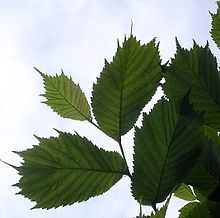Scientific name Ulmus laciniata | Genus Ulmus Rank Species | |
 | ||
Similar Ulmus macrocarpa, Ulmus davidiana, Ulmus bergmanniana, Ulmus lamellosa, Ulmus wallichiana | ||
Ulmus laciniata , known variously as the Manchurian, Cut-leaf, or Lobed Elm, is a deciduous tree native to the humid ravine forests of Japan, Korea, northern China, eastern Siberia and Sakhalin, growing alongside Cerciphyllum japonicum, Aesculus turbinata, and Pterocarya rhoifolia, at elevations of 700–2200 m, though sometimes lower in more northern latitudes, notably in Hokkaido.
Contents
- Description
- Pests and diseases
- Cultivation
- Notable trees
- Subspecies varieties
- Hybrid cultivars
- Accessions
- Nurseries
- References
The tree is similar to the Wych Elm Ulmus glabra, and was originally treated as such by Houtzagers and Henry, but later accorded species status of its own largely by reason of the enormous disjunction in their respective areas; U. glabra extending across Europe as far as the Urals, several thousand kilometres from U. laciniata in the Far East.
Description
Ulmus laciniata is chiefly distinguished by its leaves, often regularly incised to form between three and seven apical lobes, giving rise to its common name, the Cut-leaf Elm. [3] The tree can reach a height of 27 m, although the trunk rarely exceeds 0.5 m d.b.h. The bark is dark, grey-brown and exfoliates in flakes. The unwinged branchlets bear laciniate leaves usually obtriangular, < 18 cm in length. The perfect wind-pollinated apetalous flowers are produced on second-year shoots in April (March in England), followed in May by elliptic < 20 × 14 mm samarae lightly-notched at the apex. Growth is moderate; the trunk of one specimen planted on permanently damp, fertile soil in south Hampshire, UK, increased in diameter at breast height (d.b.h.) by a modest average of 1.7 cm per annum.
Pests and diseases
Natural populations of U. laciniata have only a marginal resistance to Dutch elm disease (DED), rated 2 out of 5, below that of the Japanese Elm. Moreover, in trials in Italy and the USA [4], U. laciniata was severely damaged by elm leaf beetles Xanthogaleruca luteola, indeed in Italy chemical controls were necessary to ensure the tree's survival, unlike its compatriots U. parvifolia and U. davidiana var. japonica which survived unscathed. The species is also susceptible to Elm Yellows.
Cultivation
The species was introduced to the West in 1905, but remains uncommon in cultivation. A specimen at the Ryston Hall, Norfolk, arboretum, obtained from the Leon Chenault nursery in Orléans, was killed by the earlier strain of Dutch elm disease prevalent in the 1930s. The tree was comprehensively evaluated in the Netherlands in the 1950s as a potential source of anti-fungal genes for use in the Dutch elm hybridization programme, but was found intolerant of all but the most sheltered and humid conditions. Trees planted in England at the Sir Harold Hillier Gardens (sole accession died 2007) and as part of Butterfly Conservation's elm trials at Great Fontley have confirmed the Dutch assessment Trees grown from seed commence flowering in their eighth year. The Dutch elm breeding programme revealed that the tree has a relatively high degree (39% seed viability) of self-fertility. The species is very difficult to propagate from hardwood cuttings, even under mist, often rooting but failing to develop foliage.
There are no known cultivars of U. laciniata, nor is it known to be in commerce beyond the USA.
Notable trees
Rarely grown in the West, and rather susceptible to DED, there are few, if any, notable trees in cultivation. The original TROBI Champion planted at the Sir Harold Hillier Gardens, Romsey, in 1982 died from DED 27 years later. The oldest known trees in the UK, planted in 1981, are at the Harcourt Arboretum in Oxfordshire.
Subspecies & varieties
A putative variety was recognized by Rehder: Ulmus laciniata var. nikkoensis - the Nikko Elm, discovered as a seedling near Lake Chuzenji, near Nikkō, Japan, and obtained by the Arnold Arboretum in 1905. The taxonomy of the tree remains a matter of contention, and has been considered possibly a hybrid of U. laciniata and U. davidiana var. japonica. However, in crossability experiments at the Arnold Arboretum in the 1970s, U. laciniata, a protogynous species, was found to be incompatible with U. davidiana var. japonica, which is protandrous.
Hybrid cultivars
Several hybrid cultivars were raised as part of the Dutch elm breeding programme at Wageningen (Heybroek, 1993), crossing the species with hybrids of U. wallichiana and U. minor to produce Clone no. 560, which in turn was crossed with Clone 720 (itself a complex cross involving U. glabra, U. minor, U. wallichiana, and U. pumila) to produce Clone 1234. None of these clones has been commercially released.
